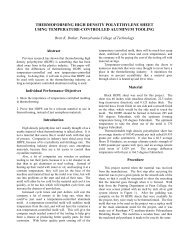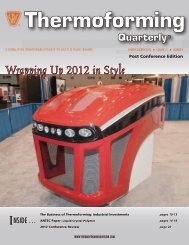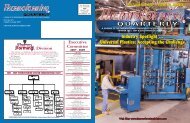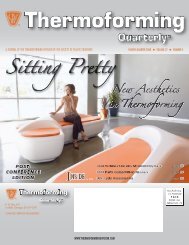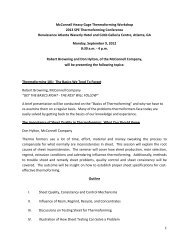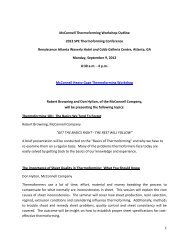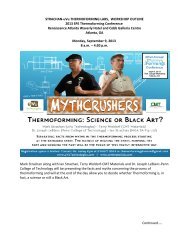Third Quarter - SPE Thermoforming Division
Third Quarter - SPE Thermoforming Division
Third Quarter - SPE Thermoforming Division
You also want an ePaper? Increase the reach of your titles
YUMPU automatically turns print PDFs into web optimized ePapers that Google loves.
draw ratio. A six-cavity mold was<br />
used. The criterion was to develop a<br />
DPET cycle time and then optimize<br />
the cycle. The criteria were both the<br />
relative clarity and formation of the<br />
part. A panel of three judged relative<br />
clarity and, formation was judged by a<br />
trained GN technician.<br />
DPET was first trialed using the<br />
standard APET cycle time. Preheats<br />
and cycle time were then adjusted to<br />
optimize the cycle time. The clarity<br />
and formation of parts were ranked at<br />
each change. Once an optimum cycle<br />
was obtained the recipe was noted. In<br />
this trial the formation of the part was<br />
always good however; the loss of clarity<br />
was noted if the temperature/time was<br />
pushed beyond optimum. The surface<br />
temperature was then measured using<br />
temperature strips. The temperature<br />
was noted to be approximately 100 o C.<br />
The cycle time for DPET was noted<br />
to be 4.08 seconds.<br />
Once optimization was obtained, a<br />
10-minute trial of DPET was run.<br />
The material ran without any trouble<br />
over this period of time. The machine<br />
was left idle for over an hour and the<br />
DPET cycle was run again. The<br />
machine produced good parts on the<br />
second cycle and again had no trouble<br />
during the 10-minute run time. As a<br />
further test for reproducibility a second<br />
roll of DPET was mounted on the<br />
machine from a different cycle in the<br />
same production lot of DPET. Again<br />
the material produced good parts on<br />
the second cycle and performed well<br />
throughout the cycle test.<br />
As a final trial, the original DPET<br />
roll was remounted on the machine;<br />
the trial was run to determine how<br />
fast DPET could be run. The cycle<br />
time was reduced to 3.32 seconds with<br />
good parts being formed.<br />
RPET was then mounted on the<br />
machine. The first trial was run at<br />
the DPET settings. The resultant<br />
parts were well formed, but showed<br />
significant haze. The cycle time and<br />
temperatures were adjusted to obtain<br />
the clearest parts. The clearest parts<br />
were obtained when the preheat<br />
temperature was reduced and the<br />
dwell increased. The overall optimum<br />
cycle time for RPET was determined<br />
to be 4.43 seconds. The surface<br />
temperature was tested and found to<br />
be approximately 96 o C. The results of<br />
this test showed RPET did not adsorb<br />
heat as fast as DPET and retain<br />
clarity.<br />
APET was mounted on the machine<br />
and optimized per the same procedure<br />
as outlined. The results were a cycle<br />
time of 4.42 seconds for APET. Again<br />
the trial shows APET did not adsorb<br />
heat as fast as DPET and retain<br />
clarity.<br />
Other trials at GN had been run using<br />
20 mil DPET and the results were<br />
essentially the same with DPET<br />
running faster than either RPET or<br />
APET. The average cycle time will<br />
vary with gauge and part configuration.<br />
DPET runs consistently 10% faster<br />
than the APET and RPET.<br />
<strong>SPE</strong>CIFIC WEIGHT<br />
SHEET PRICE<br />
SCRAP PRICE<br />
% SKELETAL WASTE AND SCRAP<br />
ENERGY CONSUMPTION (GN)<br />
NUMBER OF CAVITIES PER TOOL<br />
ORDER SIZE<br />
COST OF LABOR<br />
ELECTRICITY<br />
Table 2. Variables Common to All Materials.<br />
1.35<br />
1.63<br />
0.38<br />
11<br />
6.8<br />
10<br />
2000000<br />
19.20<br />
0.128<br />
A field trial was run at a commercial<br />
thermoformer on a GN machine.<br />
After starting with the standard cycle<br />
time, we then increased the cycle time<br />
by over 10%. The cycle time was not<br />
running at standard at the time of the<br />
trial. At the end of the trial we had<br />
decreased the cycle time greater than<br />
the 10% over standard. The check of<br />
the surface temperature at optimum<br />
showed a value of between 98 o C. and<br />
100 o C.<br />
COST MODELS<br />
Two cost models were developed,<br />
one by GN and the other by OCTAL.<br />
The two models basically present the<br />
same results.<br />
The aim of this model is to compare<br />
three different materials APET,<br />
DPET and RPET on GN machines<br />
(contact) versus radiant machines.<br />
Table 2 represents variables that are<br />
common to all materials.<br />
1.35<br />
1.63<br />
0.38<br />
256.8<br />
70<br />
2000000<br />
19.20<br />
0.128<br />
g/cm 3<br />
$/Kg<br />
$/Kg<br />
%<br />
KW/machine<br />
N/A<br />
N/A<br />
$/Hr<br />
$/KwHr<br />
Table represents variables that are used to run the cost model. The above variables are used for the<br />
example model in this article.<br />
The user has to enter a certain set of<br />
data to run the model as shown in Table<br />
3 on the following page. To show an<br />
example of how the model works, we<br />
have taken a case of 2,000,000 trays<br />
(252 x 110 mm or 10" x 4.33") at 250<br />
microns (APET sheet) and a total of 10<br />
trays per cycle. Earlier tests show that<br />
APET runs at 13.51 cycles per minute.<br />
The cycles per minute of other materials<br />
are calculated based on test results at<br />
GN labs. The user can opt to run the<br />
model either on contact machine (GN)<br />
or radiant machine. For this example,<br />
we opted for contact heat. Based on<br />
the type of machine, the scrap plus<br />
waste and energy consumption will<br />
change. For contact heat, the skeletal<br />
waste and scrap is calculated to be<br />
11% (25% for radiant machines)<br />
energy consumption is rated at 6.8<br />
KW (70 KW for radiant machines).<br />
The model is based on two contact<br />
machines versus one radiant machine<br />
in order to level the throughput of<br />
machines for comparison. Other data<br />
that need to be entered by the user<br />
include cost of labor, cost of raw<br />
(continued on next page)<br />
<strong>Thermoforming</strong> QUArTerLY 15



